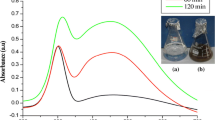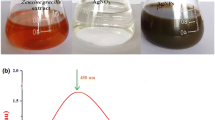Abstract
The developments of resistance and persistence to chemical insecticides and concerns about the non-target effects have prompted the development of eco-friendly mosquito control agents. The aim of this study was to investigate the larvicidal activities of synthesized cobalt nanoparticles (Co NPs) using bio control agent, Bacillus thuringiensis against malaria vector, Anopheles subpictus and dengue vector, Aedes aegypti (Diptera: Culicidae). The synthesized Co NPs were characterized by X-ray diffraction (XRD), Fourier transform infrared (FTIR), Field-emission scanning electron microscopy (FESEM) with energy dispersive X-ray spectroscopy, and Transmission electron microscopy (TEM). XRD analysis showed three distinct diffraction peaks at 27.03°, 31.00°, and 45.58° indexed to the planes 102, 122, and 024, respectively on the face-centered cubic cobalt acetate with an average size of 85.3 nm. FTIR spectra implicated role of the peak at 3,436 cm−1 for O–H hydroxyl group, 2924 cm−1 for methylene C–H stretch in the formation of Co NPs. FESEM analysis showed the topological and morphological appearance of NPs which were found to be spherical and oval in shape. TEM analysis showed polydispersed and clustered NPs with an average size of 84.81 nm. The maximum larvicidal mortality was observed in the cobalt acetate solution, B. thuringiensis formulation, and synthesized Co NPs against fourth instar larvae of A. subpictus and A. aegypti with LC50 values of 29.16, 8.12, 3.59 mg/L; 34.61, 6.94, and 2.87 mg/L; r 2 values of 0.986, 0.933, 0.942; 0.962, 0.957, and 0.922, respectively.




Similar content being viewed by others
References
Barreto ML, Teixeira MG (2008) Dengue no Brasil: situação epidemiológica e contribuições para uma agenda de pesquisa. Rev Estud Avançados 22(64):53–72
Becker N, Petric D, Zgomba M, Boase C, Madon M, Dahl CD, Kaiser A (2010) Mosquitoes and their control. Springer, Heidelberg, p 577
Bellows TS (2001) Restoring population balance through natural enemy introductions. Biol Cont 21:199–205
Chandra G, Bhattacharjee I, Chatterjee S (2010) A review on Anopheles subpictus Grassi a biological vector. Acta Trop 15(2):142–154
Chatterjee SN, Chandra G (2000) Role of Anopheles subpictus as a primary vector of malaria in an area in India. Jpn J Trop Med Hyg 28(3):177–181
Chatterjee S, Subhra Ghosh T, Das S (2010) Virulence of Bacillus cereus as natural facultative pathogen of Anopheles subpictus Grassi (Diptera: Culicidae) larvae in submerged rice-fields and shallow ponds. African J Biotechnol 9(41):6983–6987
Coates J (2000) In: Meyers RA (ed) Interpretation of infrared spectra, a practical approach. Encyclopedia of analytical chemistry. Wiley, Chichester, pp 10815–10837
Daniel T, Umarani S, Sakthivadivel M (1995) Insecticidal action of Ervatamia divaricata L. and Acalypha indica L. against Culex quinquefasciatus Say. Geobios 14:95–98
Deepika TL, Kannabiran K, Khanna VG, Rajakumar G, Jayaseelan C, Santhoshkumar T, Rahuman AA (2012) Isolation and characterisation of acaricidal and larvicidal novel compound (2S,5R,6R)-2-hydroxy-3,5,6-trimethyloctan-4-one from Streptomyces sp. against blood-sucking parasites. Parasitol Res 111(3):1151–1163
Dhanasekaran D, Sakthi V, Thajuddin N, Panneerselvam A (2010) Preliminary evaluation of Anopheles mosquito larvicidal efficacy of mangrove actinobacteria. IJABPT 1(2):374–381
Dhanda V, Kaul HN (1980) Mosquito vectors of Japanese encephalitis virus and their bionomics in India. Proc Indian Natl Sci Acad B46(1):759–768
Guzman MG, Halstead SB, Artsob H, Buchy P, Jeremy F, Gubler DJ (2010) Dengue: a continuing global threat. Nat Rev Microbiol 8(12 Suppl):S7–S16
Headrick DH, Goeden RD (2001) Biological control as a tool for ecosystem management. Biol Cont 21:249–257
Jain D, Kachhwaha S, Jain R, Srivastava G, Kothari SL (2010) Novel microbial route of synthesize silver nanoparticles using spore crystal mixture of Bacillus thuringiensis. Indian J Exp Biol 48:1152–1156
James AA (1992) Mosquito molecular genetics: the hands that feed bite back. Science 257:37–38
Jha AK, Prasad K (2012) Biological synthesis of cobalt ferrite nanoparticles. Nanotechnol Dev 2(e9):46–51
Jha AK, Prasad K, Kulkarni AR (2009) Synthesis of TiO2 nanoparticles using microorganisms. Colloids Surf B Biointerfaces 71:226–229
Joseph ARK, Viswanathan B (2011) Synthesis of cobalt nanoparticles with vegetable oil as the stabilizing agent. Bull Cat Soc Infias 9:6–12
Jude PJ, Tharmasegaram T, Sivasubramaniyam G, Senthilnanthanan M, Kannathasan S, Raveendran S, Ramasamy R, Surendran SN (2012) Salinity-tolerant larvae of mosquito vectors in the tropical coast of Jaffna, Sri Lanka and the effect of salinity on the toxicity of Bacillus thuringiensis to Aedes aegypti larvae. Parasitol Vect 5(269):2–8
Kamaraj C, Bagavan A, Rahuman AA, Zahir AA, Elango G, Pandiyan G (2009) Larvicidal potential of medicinal plant extracts against Anopheles subpictus Grassi and Culex tritaeniorhynchus Giles (Diptera: Culicidae). Parasitol Res 104:1163–1171
Kaushik R, Saini P (2008) Larvicidal activity of leaf extract of Millingtonia hortensis (Family: Bignoniacear) against Anopheles stephensi, Culex quinquefasciatus and Aedes aegypti. J Vec Borne Dis 45:66–69
Klempner MS, Unnasch TR, Hu LT (2007) Taking a bite out of vector-transmitted infectious diseases. N Engl J Med 356(25):2567–2569
Kovendan K, Murugan K, Prasanna Kumar K, Panneerselvam C, Mahesh Kumar P, Amaresan D, Subramaniam J, Vincent S (2012) Mosquitocidal properties of Calotropis gigantea (Family: Asclepiadaceae) leaf extract and bacterial insecticide, Bacillus thuringiensis, against the mosquito vectors. Parasitol Res 111(2):531–544
Manonmani AM, Hoti SL (1995) Field efficacy of indigenous strains of Bacillus thuringiensis H-14 and Bacillus sphaericus H-5a5b against Anopheles subpictus larvae. Trop Biomed 12(2):141–146
Marimuthu S, Rahuman AA, Rajakumar G, Santhoshkumar T, Kirthi AV, Jayaseelan C, Bagavan A, Zahir AA, Elango G, Kamaraj C (2011) Evaluation of green synthesized silver nanoparticles against parasites. Parasitol Res 108(6):1541–1549
Mukhtar M, Herrel N, Amerasinghe FP, Ensink J, van der Hoek W, Konradsen F (2003) Role of wastewater irrigation in mosquito breeding in south Punjab, Pakistan. Southeast Asian J Trop Med Public Health 34:72–80
Murugesan AG, Prabu SC, Selvakumar C (2009) Biolarvicidal activity of extracellular metabolites of the keratinophilic fungus Trichophyton mentagrophytes against larvae of Aedes aegypti—a major vector for chikungunya and dengue. Folia Microbiol 54(3):213–216
Patil CD, Patil SV, Salunke BK, Salunkhe RB (2012) Insecticidal potency of bacterial species Bacillus thuringiensis SV2 and Serratia nematodiphila SV6 against larvae of mosquito species Aedes aegypti, Anopheles stephensi, and Culex quinquefasciatus. Parasitol Res 110(5):1841–1847
Pauline S, Amaliya AP (2012) Size and shape control evaluation of cobalt (Co) and cobalt ferrite (CoFe2O4) magnetic nanoparticles. Arch Phys Res 3(2):78–83
Poopathi S, Anupkumar K, Arunachalam N, Sekar V, Tyagi BK (2003) A small scale mosquito control field trial with the biopesticides Bacillus sphaericus and Bacillus thuringiensis serovar israelensis produced from a new culture medium. Biocontrol Sci Tech 13:743–748
Prabakaran G, Hoti SL (2008) Immobilization of alginate-encapsulated Bacillus thuringiensis var. israelensis containing different multivalent counterions for mosquito control. Curr Microbiol 57(2):111–114
Prabhu K, Murugan K, Nareshkumar A, Bragadeeswaran S (2011) Larvicidal and pupicidal activity of spinosad against the malarial vector Anopheles stephensi. Asian Pac J Trop Med 610–613
Prakash A, Sharma S, Ahmad N, Ghosh A, Sinha P (2010) Bacterial mediated extracellular synthesis of metallic nanoparticles. Int Res J Biotechnol 1:71–79
Rahuman AA, Gopalakrishnan G, Ghouse BS, Arumugam S, Himalayan B (2000) Effect of Feronia limonia on mosquito larvae. Fitoterapia 71(5):553–555
Rajakumar G, Rahuman AA (2011) Larvicidal activity of synthesized silver nanoparticles using Eclipta prostrata leaf extract against filariasis and malaria vectors. Acta Trop 118:196–203
Ramaiah KD, Das PK, Michael E, Guyatt H (2000) The economic burden of lymphatic filariasis in India. Parasitol Today 16(6):251–253
Rana S, Philip J, Raj B (2010) Micelle based synthesis of cobalt ferrite nanoparticles and its characterization using Fourier transform infrared transmission spectrometry and thermogravimetry. Mat Chem Phys 124:264–269
Rao TR (1984) The Anophelines of India. Malaria Research Centre (ICMR), Delhi, p 518
Rashmi K, Krishnaveni T, Ramanamurthy S, Maruthi Mohan P (2004) Characterization of Cobalt nanoparticle from a Cobalt resistant strain of Neurospora crassa International Symposium of Research Students on Materials Science and Engineering December 20–22
Reddy PJ, Krishna D, Murthy US, Jamil K (1992) A microcomputer FORTRAN program for rapid determination of lethal concentration of biocides in mosquito control. Comput Appl Biosci 8:209–213
Salunkhe RB, Patil SV, Patil CD, Salunke BK (2011) Larvicidal potential of silver nanoparticles synthesized using fungus Cochliobolus lunatus against Aedes aegypti (Linnaeus, 1762) and Anopheles stephensi Liston (Diptera; Culicidae). Parasitol Res 109:823–831
Sanpo N, Wang J, Berndt CC (2013) Influence of chelating agents on the microstructure and antibacterial property of cobalt ferrite nanopowders. J Aust Ceram Soc 49(1):84–91
Santhoshkumar T, Rahuman AA, Rajakumar G, Marimuthu S, Bagavan A, Jayaseelan C, Zahir AA, Elango G, Kamaraj C (2011) Synthesis of silver nanoparticles using Nelumbo nucifera leaf extract and its larvicidal activity against malaria and filariasis vectors. Parasitol Res 108(3):693–702
Saurav K, Rajakumar G, Kannabiran K, Rahuman AA, Velayutham K, Elango G, Kamaraj C, Zahir AA (2013) Larvicidal activity of isolated compound 5-(2,4-dimethylbenzyl) pyrrolidin-2-one from marine Streptomyces VITSVK5 sp. against Rhipicephalus (Boophilus) microplus, Anopheles stephensi, and Culex tritaeniorhynchus. Parasitol Res 112(1):215–226
Singh CP, Singh KN, Pandey MC (1996) Insect growth regulatory effect of neem derivative “Neemolin” on Spilosoma obligue Walker. Pestology 5:11–13
Soni N, Prakash S (2012) Synthesis of gold nanoparticles by the fungus Aspergillus niger and its efficacy against mosquito larvae. Rep Parasitol 2012(2):1–7
Subramaniam J, Murugan K, Kovendan K (2012) Larvicidal and pupcidal efficacy of Momordica charantia leaf extract and bacterial insecticide, Bacillus thuringiensis against malarial vector, Anopheles stephensi Liston. (Diptera: Culicidae). J Biopest 5:163–169
Suman TY, Elumalai D, Kaleena PK, Radhika Rajasree SR (2013) GC–MS analysis of bioactive components and synthesis of silver nanoparticle using Ammannia baccifera aerial extract and its larvicidal activity against malaria and filariasis vectors. Ind Crop Prod 47:239–245
Thanh NTK, Puntes VF, Tung LD, Fernig DG (2005) Peptides as capping ligands for in situ synthesis of water soluble Co nanoparticles for bioapplications. J Phys Conf Ser 17:70–76
Thenmozhi M, Gopal JV, Kannabiran K, Rajakumar G, Velayutham K, Rahuman AA (2013) Eco-friendly approach using marine actinobacteria and its compounds to control ticks and mosquitoes. Parasitol Res 112(2):719–729
Vijayan V, Balaraman K (1991) Metabolites of fungi & actinomycetes active against mosquito larvae. Indian J Med Res 93:115–117
Wang XS, Wang H, Coombs N, Winnik MA, Manners I (2005) Redox-induced synthesis and encapsulation of metal nanoparticles in shell-cross-linked organometallic nanotubes. J Am Chem Soc 127(25):8924–8925
WHO (2005) Sixth meeting of the technical advisory group on the global elimination of lymphatic filariasis, Geneva, Switzerland. Wkly Epidemiol Rec 80:401–408
World Health Organization WHO (1996) Report of the WHO informal consultation on the evaluation on the testing of insecticides. CTD/WHO PES/IC/ 96.1. Geneva: p. 69
World Health Organization WHO (2009) Dengue guidelines for diagnosis, treatment, prevention and control. Available at:http://whqlibdoc.who.int/publications/2009/9789241547871_eng. pdf. Accessed February 10, 2010
Zhou G (2011) Microwave assisted synthesis of cobalt phosphate nanoparticles and their antiproliferation against human lung cancer cells and primary osteoblasts in vitro. Int J Chem 3(4):127–133
Acknowledgments
The authors are grateful to C. Abdul Hakeem College Management, Dr. S.Y. Anver Sheriff, Principal, Dr. Hameed Abdul Razack, HOD of Zoology Department, for providing the facilities to carry out this work. Mr. S. Marimuthu gratefully thanks University Grants Commission (UGC-RGNF-JRF-F1-17.1/2011-12/RGNF-SC-TAM-6614 /(SA-III/Website)) Government of India, New Delhi for financial support to carry out this work.
Author information
Authors and Affiliations
Corresponding author
Rights and permissions
About this article
Cite this article
Marimuthu, S., Rahuman, A.A., Kirthi, A.V. et al. Eco-friendly microbial route to synthesize cobalt nanoparticles using Bacillus thuringiensis against malaria and dengue vectors. Parasitol Res 112, 4105–4112 (2013). https://doi.org/10.1007/s00436-013-3601-2
Received:
Accepted:
Published:
Issue Date:
DOI: https://doi.org/10.1007/s00436-013-3601-2




